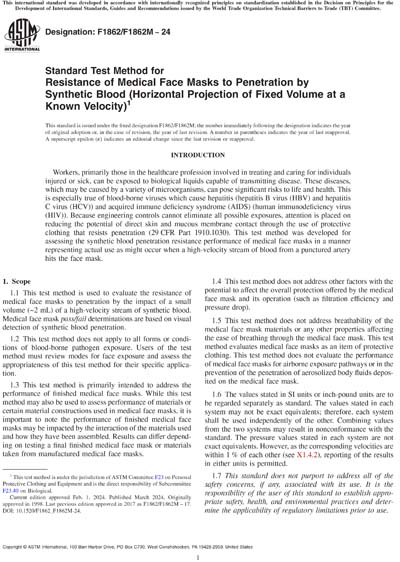Most recent
ASTM F1862/F1862M-24
Standard Test Method for Resistance of Medical Face Masks to Penetration by Synthetic Blood (Horizontal Projection of Fixed Volume at a Known Velocity)
1.1 This test method is used to evaluate the resistance of medical face masks to penetration by the impact of a small volume (~2 mL) of a high-velocity stream of synthetic blood. Medical face mask pass/fail determinations are based on visual detection of synthetic blood penetration.
1.2 This test method does not apply to all forms or conditions of blood-borne pathogen exposure. Users of the test method must review modes for face exposure and assess the appropriateness of this test method for their specific application.
1.3 This test method is primarily intended to address the performance of finished medical face masks. While this test method may also be used to assess performance of materials or certain material constructions used in medical face masks, it is important to note the performance of finished medical face masks may be impacted by the interaction of the materials used and how they have been assembled. Results can differ depending on testing a final finished medical face mask or materials taken from manufactured medical face masks.
1.4 This test method does not address other factors with the potential to affect the overall protection offered by the medical face mask and its operation (such as filtration efficiency and pressure drop).
1.5 This test method does not address breathability of the medical face mask materials or any other properties affecting the ease of breathing through the medical face mask. This test method evaluates medical face masks as an item of protective clothing. This test method does not evaluate the performance of medical face masks for airborne exposure pathways or in the prevention of the penetration of aerosolized body fluids deposited on the medical face mask.
1.6 The values stated in SI units or inch-pound units are to be regarded separately as standard. The values stated in each system may not be exact equivalents; therefore, each system shall be used independently of the other. Combining values from the two systems may result in nonconformance with the standard. The pressure values stated in each system are not exact equivalents. However, as the corresponding velocities are within 1 % of each other (see X1.4.2), reporting of the results in either units is permitted.
1.7 This standard does not purport to address all of the safety concerns, if any, associated with its use. It is the responsibility of the user of this standard to establish appropriate safety, health, and environmental practices and determine the applicability of regulatory limitations prior to use.
1.8 This international standard was developed in accordance with internationally recognized principles on standardization established in the Decision on Principles for the Development of International Standards, Guides and Recommendations issued by the World Trade Organization Technical Barriers to Trade (TBT) Committee.
Content Provider
ASTM International [astm]






